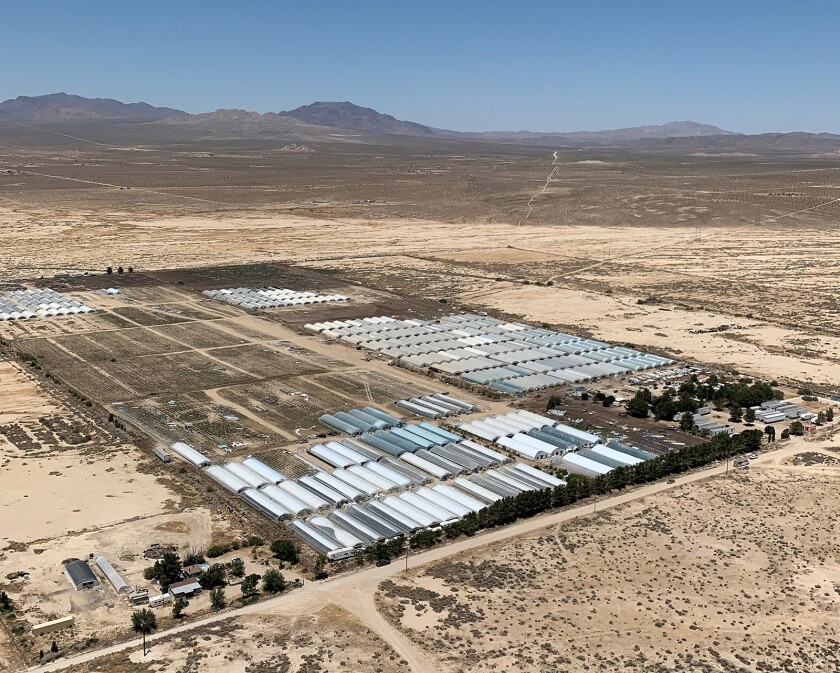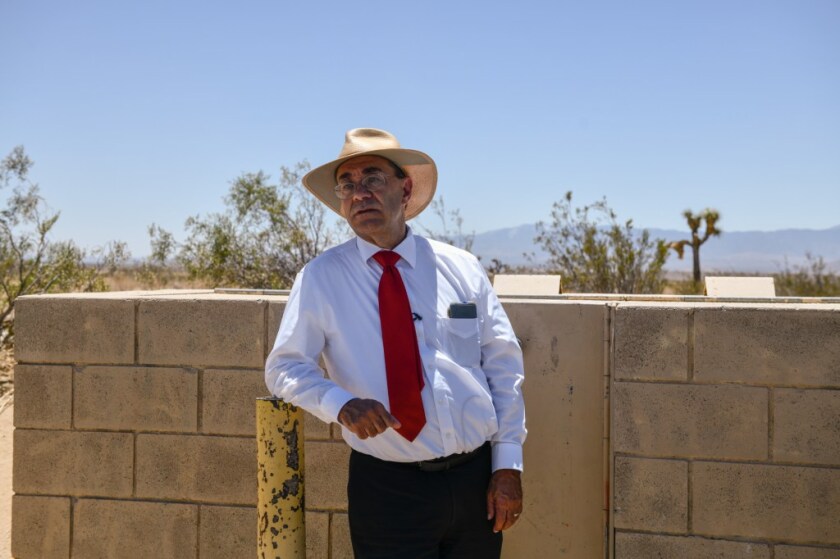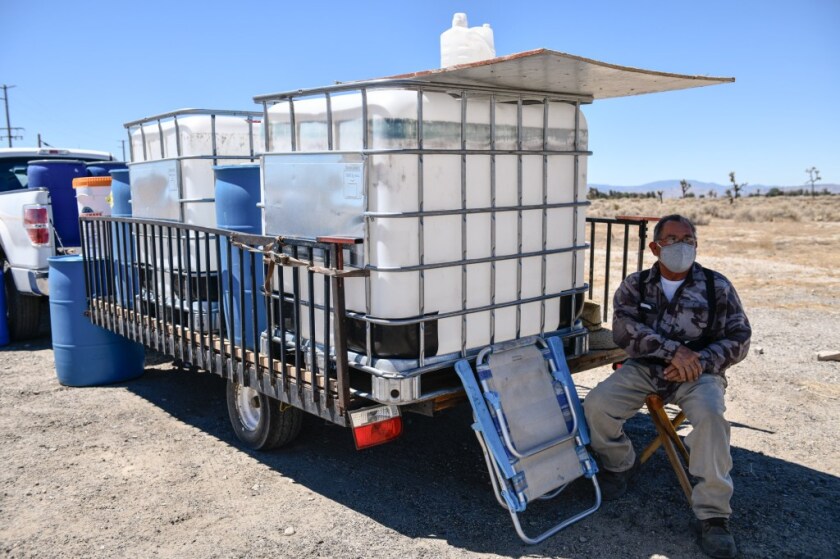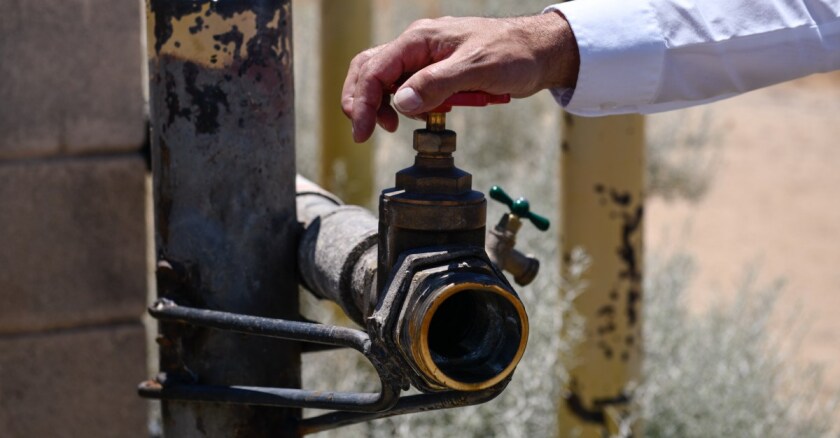The emergency was so dire in the water-stressed desert area of Hi Vista, between Los Angeles and Mojave, that county health officials considered ordering residents to boil their tap water before drinking it.
“We said, ‘Holy cow, what’s happening?’” said Anish Saraiya, public works deputy for Los Angeles County Supervisor Kathryn Barger.
It took a while for officials to figure out where all that water was going: Water thieves — likely working for illicit marijuana operations — had pulled water from remote filling stations and tapped into fire hydrants, improperly shutting off valves and triggering a chain reaction that threatened the water supply of nearly 300 homes.
As drought grips most of California, water thievery across the state has increased to record levels. Bandits in water trucks are backing up to rivers and lakes and pumping free water they sell on a burgeoning black market. Others, under cover of darkness, plug into city hydrants and top up. Thieves also steal water from homes, farms and private wells, and some even created an elaborate system of dams, reservoirs and pipelines during the last drought. Others are MacGyvering break-ins directly into pressurized water mains, a dangerous and destructive approach known as hot-tapping.
In Mendocino County, the thefts from rivers and streams are compromising already depleted Russian River waterways. In one water district there, thefts from hydrants could compromise a limited water supply for fighting fires, which is why they have put locks on hydrants.
“Any way that you can imagine that somebody is going to grab water, they’re doing it,” said Mendocino County Sheriff Matt Kendall. “For goodness sakes, everybody knows what is going on.”
Any way that you can imagine that somebody is going to grab water, they're doing it.
MATT KENDALL, MENDOCINO COUNTY SHERIFF
Officials say water thefts are increasing at about the same rate as the decline in California’s water supplies. Complaints have risen sharply this year, mirroring the drought’s inexorable advance.
Halfway through this year, 125 Californians have reported thefts to state authorities, more than twice as many as a decade ago. Those numbers don’t capture calls to local officials or small water districts that shoulder the bulk of enforcement responsibility.
The water thefts not only strain police agencies but also damage valuable equipment. In the Antelope Valley, water main breaks, which can cost $10,000 each to repair, had been averaging about two a year. In the past year, there have been a dozen, Saraiya said.
Water users are now proactively protecting their supplies. Many fire hydrants are being locked or removed altogether. Water tank owners have installed security cameras. In rural areas, residents who have no access to municipal water systems and rely on key-activated water stations are finding their critical lifelines are shut down because of incessant tampering. A robust black market for the keys has popped up, and now most stations operate only during daylight hours.
In the Antelope Valley city of Lancaster, impound yards are hosting growing collections of confiscated water trucks. In one area, fire authorities removed 100 of the area’s 176 hydrants deemed not essential to public safety. Remaining hydrants were fitted with locks.
No cache of water is safe. During the last major drought, businesses, schools and even a fire station were victims of water theft. In 2014, thieves pumped water from storage tanks belonging to the North San Juan Fire Protection District in Nevada County, in the mountains northeast of Sacramento.
“I came to the station one morning and there was a big wet spot,” said Boyd Johnson, the district’s former battalion chief. He said the water was taken for several weeks until they locked the system. “We share that water with CalFire, and, obviously, water was critical to firefighting.”
California’s Water and Weed
The most-common culprit of water theft: illegal pot farms. While farmers, ranchers and licensed marijuana growers scramble to obtain water through legal channels, clandestine operations are stealing it or purchasing it from illicit trucks.
In the Sierra Nevada, as many as 4,000 illegal grow sites are operating in Nevada County, according to county estimates. In the Antelope Valley, illegal grows have doubled from 200 last year to 400 today, according to county data, while other estimates put the number in the thousands.
While the vast desert affords a degree of privacy to pot operations, it lacks a critical component to growing things: water. One cannabis farmer near Lancaster bought a house simply to run a garden hose across the desert to his illegal grow site. Officials shut off the line, but the ever-resourceful thieves tapped into another underground line and kept watering their plants.

(Rich Debevec/San Bernardino Sheriff’s Department/TNS)
“Most Californians would be shocked and disappointed at the amount of water these unlicensed, illegal grows are using, especially as California suffers from a drought,” Curt Fallin, a federal Drug Enforcement Agency agent, said during a recent news conference. “By our calculation, the illegal grows in Los Angeles, Riverside and San Bernardino counties require an astounding 5.4 million gallons of water a day, every day.”
That’s enough water for 72,000 people, almost half the population of Lancaster, which is so water-short that the city imposed temporary restrictions on lawn sprinklers last month.
In far northern, mountainous Siskiyou County — which is facing extreme drought conditions this year — sheriffs estimated that during the last drought, illegal pot sites consumed two million gallons of water a day. That would supply three-quarters of the county’s residents today.
With climate change driving longer and more severe droughts around the globe, researchers last year estimated that as much as half the world’s water supply is being stolen every year, citing statistics gathered by the United Nations and Interpol in Europe.
Whack-A-Mole In The Mojave
On a recent hot July day, Charles Bostwick, an assistant field deputy for county Supervisor Barger, piloted his Jeep down mile after mile of dusty roads in the Antelope Valley, past dozens of cannabis grow sites.
Stark white “hoop houses” rise from the flat desert floor. When lit at night, the compounds cast an eerie glow. Operators make little effort to hide the sites, which are littered with trash baking in the Mojave Desert sun and guarded by armed men. Scattered along the road to one site was a porcelain toilet, plastic chairs and a coiled garden hose. Bulldozed Joshua trees lay in haphazard piles. The fender of a rusting truck was spray painted “out” and next to it was another one with “keep” scrawled on the side.

(Photo by Pablo Unzueta for CalMatters)
“We bust them and they move somewhere else and begin again,” Bostwick said. “It’s a non-stop game of whack-a-mole.”
He said drought is accelerating water theft in the already water-stressed region.
“We have no water to spare and our farmers are making do with less,” Bostwick said. “We never had water thefts here (in the Antelope Valley) two years ago. A homeless guy climbing over the fence of a trailer park and filling his five-gallon jug in the laundry room — that was our water theft.”

(Photo by Pablo Unzueta for CalMatters)
But, again, the thieves are a step ahead. When it became clear that law enforcement was on the lookout for suspicious water tankers, thieves shifted to putting 275-gallon water cubes in the back of their pickups or on trailers. More recently, they have taken to renting U-Haul vans to hide their cargo. Any conveyance with space to carry is put to work: Bostwick said someone in the area is driving around an old fire truck, and another guy is using what appears to be a converted airline fuel tanker.
The jerry-rigged water haulers are dangerous and road accidents are common, Bostwick said. A cube containing 275 gallons of water weighs a ton. Lashing such a heavy and easy-to-shift cargo on trucks can cause it to tip over. In May, the driver of a pickup truck hauling a water cube died after he lost control on a two-lane road near Lancaster and ran head-on into a semi tractor-trailer.
Everyone seems to be in the water business. Jose Huerta set up shop from his pickup at a remote desert crossroads, selling empty 55-gallon water drums for $55 and water cubes — stout plastic containers surrounded by a metal cage — for $100. Business is brisk, he said, adding that he doesn’t ask what his customers do with the containers. “Everyone needs water,” he said.

(Pablo Unzueta for CalMatters)
Gailen Kyle grows alfalfa in the arid desert on a farm he works with his wife, Julie. Their home is surrounded by illicit pot operations, which he finds both frightening and frustrating. He’s had intimidating characters come to his door pressuring him to sell out, he said, and other farmers are already reporting that illegal over-pumping is lowering production in their wells.
“I have zero water, all we have is wells,” said Kyle, whose water allocation has been reduced by 50% this year. “They cut my water and these marijuana grows are operating on stolen water. They are getting water from all over and watering hundreds of acres. This is anarchy.”
For those without wells, the problem is more acute. In Lancaster, at a water district parking lot, a water station that supplies residents was in disarray. Scraped and gouged, an armored door appeared to have been opened with a screwdriver rather than a key. A fire hose lay uncoiled on the asphalt, damp and limp.
The water station had been targeted by thieves so often that authorities shut it down. Its digital readout blinked: “Port has been disabled by host.”
Lax Penalties and Intimidation
The increase in water theft has exposed not only the vulnerabilities in the state systems to secure water, but also the complications of enforcing laws with penalties that no longer reflect the seriousness of the crime.
Authorities in California say they are working with limited tools to understand and combat the problem. In 2016 California law legalized recreational marijuana use by adults, and reduced penalties for cultivation of large quantities of pot from a felony to a misdemeanor. So law enforcement officials say it’s difficult to prosecute water theft for illegal grows because judges are circumspect about issuing search warrants for a low-level crime.
“I don’t mean to be rude, but the state is taking the word ‘criminal’ out of the dictionary,” said Marina West, general manager of the Bighorn-Desert View Water Agency, which serves about 2,000 customers north of Palm Springs.
“We’re here to provide water to this community, we’re not here to provide cheap water to an illegal business that’s making millions of dollars.”
Another impediment to more robust reporting and enforcement: intimidation. According to Kyle, the Antelope Valley farmer, one of his neighbors was shown a photograph of a bullet-riddled truck and warned by an alleged cartel member that it could be her fate if she made official complaints about the illegal cannabis sites. Growers monitor and routinely photograph anyone coming near their operations.
Two managers of Southern California water agencies backed out of interviews with CalMatters, saying they were afraid that going public with information about water theft would put their employees at risk.

(Photo by Pablo Unzueta for CalMatters)
After the last drought, in 2018, state officers found nearly 1,000 water rights violations and imposed more than $1 million in fines. Last year, inspection work was severely curtailed because of the pandemic.
“What we are recognizing is that water scarcity is the new norm. It’s offensive to see water go to support this illegal industry when legal industries are struggling for water,” said Yvonne West, the water board’s director of enforcement.
West’s department keeps an eye on 5,000 legal marijuana cultivators, but an estimated 25,000 are operating illegally “outside the program.” The imbalance keeps state enforcement efforts on a constant back foot.
“The numbers speak for themselves,” she said.
We're here to provide water to this community, we're not here to provide cheap water to an illegal business that's making millions of dollars.
MARINA WEST, BIGHORN-DESERT VIEW WATER AGENCY
“As the state enters another potential drought emergency, we need to ensure that this new activity does not further exacerbate water scarcity,” said Barger, who co-authored the Los Angeles County resolution.
A Model from Down Under
As California officials lament the lack of legal teeth to prosecute water thieves, they can find an enforcement model in Australia, the planet’s driest inhabited continent.
Illegally siphoning of the Murray and Darling rivers, which irrigate crops and livestock in Australia’s agricultural heartland, was until a few years ago common — and commonly overlooked. Fruit, grain and cotton growers operated massive pumps at will, often pulling out many times more water than legally permitted and drawing down the river during droughts.
The powerful growers stole water “with no fear of sanction,” said Grant Barnes, chief regulatory officer for the New South Wales’ natural resources department. “There were more parking wardens in a town in New South Wales than regulators in the entire state.”
Barnes estimated that tens of billions of dollars worth of water was being stolen. But Australian authorities had little understanding of the volumes pumped illegally because farmers often removed or tampered with meters. “You can’t manage what you don’t measure,” Barnes said.
That changed in 2018 when the new agency led by Barnes clamped down with a large enforcement team backed by fines and the threat of revocation of water licenses. In their three years on the beat, the new water cops — about 100 inspectors and other staffers — have prosecuted 31 cases, compared to 8 in the previous 17 years.
Farmers were told “no meter, no pump.” An accurate meter connected to the state system was mandatory before water could be pumped out of rivers.
The New South Wales team employs satellite images, drones, remote-controlled watercraft and software that compares what’s growing on farms with their legal water allocation.
“To steal water, to make it economically viable, you have to take vast volumes and you have to store it. By virtue of that storage you make yourself open to satellite technology,” Barnes said. “Now you can’t hide it.”
This story was first published by CalMatters. Read the original article.








